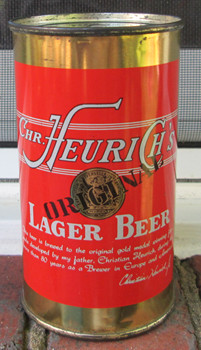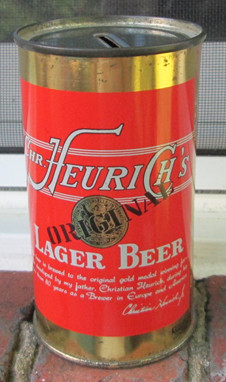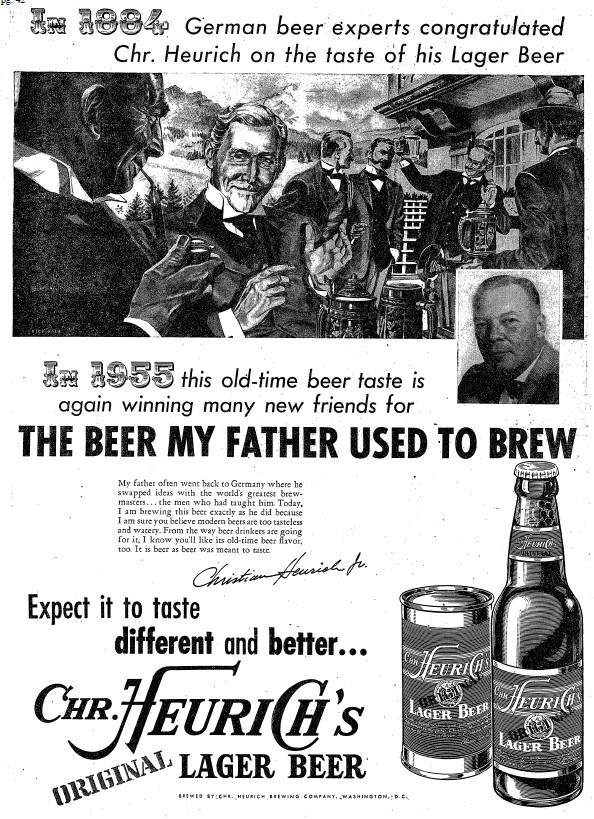Heurich Lager: 1955
 |
 |
 |
This month let's look at the last attempt by DC's Christian Heurich Brewing to recapture lost market share, Heurich Lager.
The post-war beer market took its toll on small breweries like Heurich’s. Only the biggest nationals could afford the big nation-wide advertising campaigns, or could take advantage of the cost savings of large scale production. The expanding and improved highway system freed shipping brewers from locating along rail lines to reach more parts of the country. Furthermore, consumption had dropped from pre-Prohibition leading to over-production as the numbers of barrels produced increased from 32.2 million barrels in 1934 to 85.5 in 1955. Per capita consumption of beer peaked in 1914 at 21 gallons a year. The highest figure for the 1930s was 12.6 in 1937. By 1955 it was still only 15.7 gallons a year. The number of brewers open post-Prohibition peaked at 766 in 1935. By 1950 that number had dropped to 350.
Many smaller brewers attempted to shore up their market share by coming out with special beers that did not fit the popular light, dry lager style of the 1950s. Heurich tried in 1955 with Heurich’s Lager, which was based on a pre-prohibition formula. Released in April 1955, the ads promoted the lager as “a beer that tasted like beer.” The ad copy quoted Heurich, “I felt that modern beers had just gone too far from the great old beers I remembered so well.” The following advertisements promoted Heurich’s Lager as “beer as beer was meant to be” and “The beer your father used to drink.” They featured Heurich, Senior, showing him in 1879, 1884, and accepting a medal at the 1900 Paris World’s Fair for his beer. “I knew” Chris was quoted as saying in one example, “you were tired of the thinned-out beer taste of modern beers.”
 |
 |
Two Heurich Lager Ads, click on either to see a larger version.
Heurich’s Lager was a hit. Sales increased. Heurich claimed that sales had increased, that sales in 1954 were eight percent higher than in 1953, and that 1954 was the best sales year in the past three years. He hoped, he told The Washington Post, that 1955 would be the best sales year since 1945, when they topped 200,000 barrels a year.
Heurich‘s Lager was a success, but the brewery continued to lose market share. They stopped making Senate in late 1955, concentrating on Heurich’s Lager and Old Georgetown. The loss of market share was a familiar story for the period, as was their perhaps inevitable decision to close. Most breweries in the United States were caught by the same factors and they were closing at an alarming rate. By 1956 the number of remaining American breweries was reduced to 239, a third the number that were open in 1935.
As 1955 turned to 1956 the Heurich Board of Directors decided the brewery would close before it started losing money. In early January 1956 they announced that they shut down on January 31. Amelia Heurich, a member of the Board since her husband had died in 1945, reportedly told her son, “If you think Poppa would do that, go ahead.” Mrs. Heurich did not live to see the end. She passed away on January 24, 1956, aged 89, exactly one week before the scheduled closure.
Chris Heurich blamed high beer taxes in neighboring states, the lack of a tax on beer imported into the District from elsewhere, and the many new residents who ordered the national brands. Moreover, the planned Roosevelt Bridge over the Potomac required that part of the brewery be torn down to make way, and it did not make economic sense to move the brewery to another part of the city. Employees were given a week’s pay and two weeks’ vacation pay, as well as a favorable letter of reference. Chris wrote letters to each employee himself to explain the closure. At least one local liquor store advertised a “Last Chance Sale” to buy Old Georgetown and Heurich Lager and when the last can of beer rolled down the line at Heurich it was it was an Old Georgetown.
For more on Heurich see these pages...
Old Georgetown
Senate 250
Senate Ale
Heurich's Radio Ads
You can see the short bio of Heurich I wrote in 2011 for the German Historical Institute at their site. (opens new window)
And my book on Heurich, which will be coming out in Spring 2017, published by McFarland.
